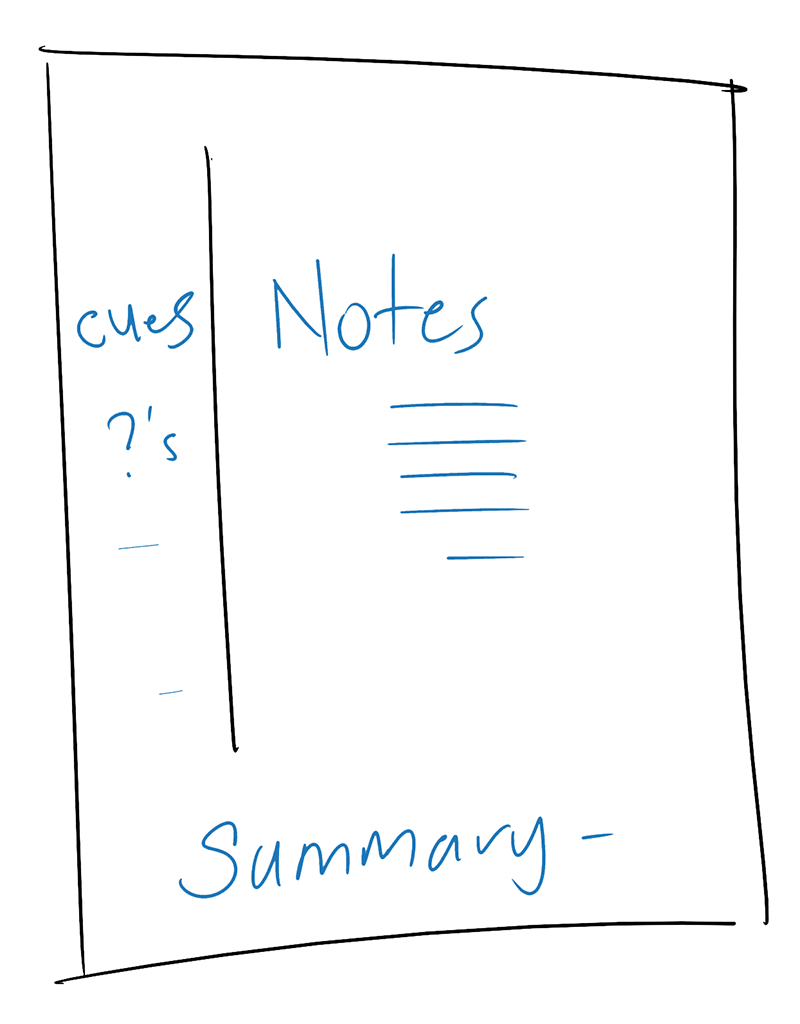Use Cornell Notes for Online Class
I've found two things that help me get more out of online classes: first is to make space and pay attention, and second I use the Cornell Note taking method during the class.
There isn't anything that different using the Cornell Note method for an online class, than an in-person class, except you can pause the teacher. This makes a big difference and allows me to organize my notes and think a little more about them during the class.
Pay Attention
Remove distractions - the greatest benefit to online courses is also the greatest challenge; you can do them anywhere. At home, at the coffee shop, wherever. The opportunity for distraction is 100x an in-person class, at the same time online is less engaging since you miss all the physical and social clues being in the same room as another person.
During an online course at home it is easy for interruptions, maybe your child, spouse, or roommate. Set aside time for the lecture, ask not to be interrupted for the next 40 minutes or whatever you need.
Tidy up your computer workspace too, close all external tabs, turn off chat apps and any notifications. Prep ahead so you'll have less distractions during the video lesson.
Take it serious - if you are looking at taking a class on something you want to learn, it requires a level of focus. It's not typically something you can open in a new window and play while you work. You need to take the course serious, most material you can't learn simply by osmosis of it playing in the background.
Cornell Note-taking System
The Cornell Note taking system is diving your sheet of paper into sections. Two columns dividing the page, roughly 30% on the left, and 70% on the right; leaving a row at the bottom, roughly 15%.

The largest section is intended for notes taken during the lecture. The left column is called the Cue column, this is used after class to capture questions or cues about the notes.
For example, a cue might be "Battle of Yorktown" and the notes could be "Yorktown Virginia, the last major battle in Revolutionary War in 1781, the British surrender to Washington, and beginning of peace negotiations".
The bottom portion of the page is to write a summary of the notes on the page in your own words, review and reflect on the material and summarize.
After taking notes, the Cornell method recommends reviewing and reflecting on the notes frequently.
- Cover the notes column and quiz yourself using the cue column.
- As you progress in the course, read the summary again thinking about how the earlier knowledge builds on the later.
How I use the Cornell Method
I take all my notes by hand writing them down as I watch the video. This helps me focus, and forces me to pay attention. Plus, I don't have to jump back and forth between windows or have two things open on my laptop. I open the lecture full-screen on the laptop, and have my notebook in front of me taking notes.
Plus, researchers say taking notes by hand involves more cognitive engagement that leads to deeper understanding. 2
How I use the Cornell Note method for an online class is similar, I draw a line down the page, dividing my page into the same sections and used more or less the same.
During the lecture, I will often pause, rewind, and watch anything that didn't make sense or wasn't clear. Listening a couple times helps. If it is math related, I might try to work it out alongside to make sure I understand.
I try to take full advantage of having the extra control around the lecture, if I find myself zoning out and barely paying attention. I might stop, take the dog for a walk or come back to it later. By taking notes and actively writing down on paper helps prevents me zoning out, but it does still happen, I find it best to recognize it.
After the lecture, I follow a similar method by writing up cues or questions about the material in the left column of the page. As well as summarizing the notes in my own words.
I try to stagger my review, using spaced repetition throughout the course, depending on the course or material I will review the previous lesson, and then skim further back maybe only reading the summaries.
I don't always transfer my notes to the computer, though that may depend on the material and what I want to do with it. Retyping them in is another method of review and summarizing, plus having a digital form makes for much easier searching later.
Summary
I use the Cornell note taking method as a structured means to focus when taking an online class—writing notes by hand forces me to pay attention. If it is something I want to learn, I try to give it space, avoid distractions, and take it serious. As most things in life, you get out of it what you put in.